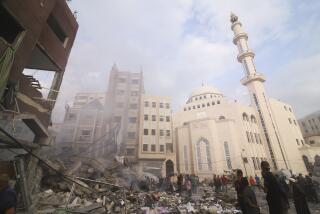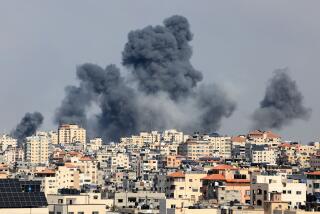Arsenal Barrage Kills 54 in Baghdad
BAGHDAD — Rockets slammed into buildings, bombs exploded on the streets and mortar rounds fell from the sky before nightfall Thursday in an apparently coordinated strike on this capital that killed at least 54 people and injured 196, authorities said.
The attacks, which occurred as residents were returning home on the eve of the weekly Islamic holy day, struck a broad swath of largely Shiite Muslim districts in east Baghdad, immediately raising suspicions of sectarian motives in this deeply divided city.
The arsenal unleashed on the civilian targets included at least four Katyusha rockets, two car bombs, two roadside bombs and a pair of mortar shells, police sources said. All detonated during a 25-minute period beginning at 6:05 p.m.
Those killed included at least 13 women and a dozen children, authorities said. The death toll was expected to rise. The wounded and dying were taken to five hospitals, which reportedly were overwhelmed.
The attack provided a grim end to a month in which U.S. and Iraqi authorities had been lauding the early results of a joint security crackdown in the capital involving 8,000 U.S. troops and 3,000 Iraqi soldiers. For much of August, the death toll in Baghdad appeared to have dropped substantially, but since Sunday, the number of killings has once again soared.
The explosions ended shortly before President Bush spoke at an American Legion convention in Salt Lake City, where he rejected the contention that sectarian violence in Iraq was turning into civil war.
U.S. commanders and diplomats in Iraq “report that only a small number of Iraqis are engaged in sectarian violence, while the overwhelming majority want peace and a normal life in a unified country,” Bush said.
The speech was the start of a campaign designed to shore up flagging public support for the U.S. presence in Iraq.
In his address, the president linked the conflict in Iraq to the U.S.-declared war on terrorism, which he called “the decisive ideological struggle of the 21st century.”
Thursday’s strike, one of the most deadly in Baghdad in recent months, displayed a level of coordination not seen here in some time.
In recent months, officials have said that Shiite-led death squads had become the nation’s most prolific killers, usually seeking out Sunni Arabs. But the latest attacks, targeting Shiite neighborhoods with bombs and missiles, had the hallmarks of well-organized insurgent cells working in tandem, not Shiite gunmen.
No one took responsibility for the attacks, but if they were the work of Sunni insurgent groups, that would be evidence that the groups had retained their ability to launch high-profile and well-planned operations that exact a horrific toll in civilian lives.
U.S. officials had hoped that the death in June of insurgent leader Abu Musab Zarqawi and the capture of some of his followers had disrupted guerrilla operations.
The ferocity of the blitz seemed to stun even residents of a city accustomed to a daily fare of car bombs, ambushes and artillery shots.
The targets were spread out along a 12-mile arc on the east side of the Tigris River, spanning at least half a dozen neighborhoods, including both Shiite-dominated and mixed Shiite-Sunni areas.
The continuing sectarian violence here has prompted many residents to move from formerly integrated communities to areas where their sect predominates and militias provide some measure of protection. In general, east Baghdad is mostly Shiite, and the Sunni enclaves occupy the west bank of the Tigris.
The barrage of rockets on Thursday appear to have been synchronized with the nearly simultaneous onslaught of mortar strikes, car bombs and roadside bombs, attesting to the sophistication of the assault. Nearby rocket strikes followed the car bombings, which occurred in two neighborhoods.
The targets included a popular market and at least three buildings, authorities said.
The broad scope of the operation indicated that separate teams of assailants operating on a fixed timetable were involved in its execution. Many insurgent cell leaders are said to be former military officers under Saddam Hussein, the Iraqi president who was ousted by U.S.-led troops in 2003.
Authorities here regularly find jury-rigged rocket and mortar launching pads in backyards, in pickup trucks, on streets and even in donkey carts. Clandestine factories rig vehicle bombs and insurgent groups provide a steady stream of willing suicide attackers, including volunteers from other Muslim nations.
The attacks struck at a pivotal time for beleaguered Iraqi Prime Minister Nouri Maliki, who recently launched a national reconciliation campaign. Maliki is expected to take his message of reconciliation to parliament when it reconvenes next week after a two-month summer break, though his specific plan is not known.
The prime minister told reporters Thursday that he hoped Iraqi forces would be able to take over security responsibilities for most of the country by year’s end.
Maliki said that Iraqi forces would soon take charge of security in the southern province of Dhi Qar, making it the second of 18 provinces under Iraqi authority.
The nation’s military took over Muthanna province, also in the south, from the British in July.
The two southern provinces are comparatively peaceful in a nation where most violence is concentrated in and around Baghdad and in several provinces to the north and east of the capital that have large Sunni Arab populations.
On Wednesday, Army Gen. George W. Casey Jr., the top U.S. commander in Iraq, predicted that Iraqis would assume overall control of their nation’s security within 12 to 18 months “with very little coalition support.”
U.S. authorities announced Thursday that attacks killed two soldiers and a Marine, bringing to at least 2,635 the American death toll since the U.S.-led invasion in 2003, the Pentagon said.
Earlier in the day, police said, a suicide car bombing near a gas station in east Baghdad killed two civilians and wounded 13 others. A roadside bomb targeted a British diplomatic convoy in western Baghdad, injuring two passersby.
*
*
Times staff writer Saif Hameed and special correspondents contributed to this report.
More to Read
Sign up for Essential California
The most important California stories and recommendations in your inbox every morning.
You may occasionally receive promotional content from the Los Angeles Times.










